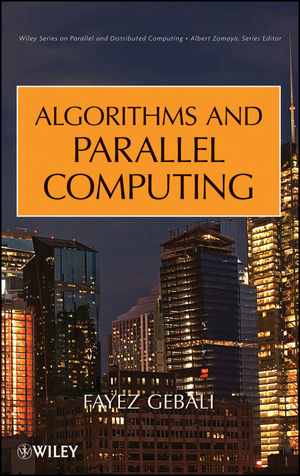
Algorithms and Parallel Computing
John Wiley & Sons Inc (Verlag)
978-0-470-90210-3 (ISBN)
There is a software gap between the hardware potential and the performance that can be attained using today's software parallel program development tools. The tools need manual intervention by the programmer to parallelize the code. Programming a parallel computer requires closely studying the target algorithm or application, more so than in the traditional sequential programming we have all learned. The programmer must be aware of the communication and data dependencies of the algorithm or application. This book provides the techniques to explore the possible ways to program a parallel computer for a given application.
Fayez Gebali, PhD, has taught at the University of Victoria since 1984 and has served as the Associate Dean of Engineering for undergraduate programs since 2002. He has contributed to dozens of journals and technical reports and has completed four books. Dr. Gebali's primary research interests include VLSI design, processor array design, algorithms for computer arithmetic, and communication system modeling.
Preface xiii
List of Acronyms xix
1 Introduction 1
1.1 Introduction 1
1.2 Toward Automating Parallel Programming 2
1.3 Algorithms 4
1.4 Parallel Computing Design Considerations 12
1.5 Parallel Algorithms and Parallel Architectures 13
1.6 Relating Parallel Algorithm and Parallel Architecture 14
1.7 Implementation of Algorithms: A Two-Sided Problem 14
1.8 Measuring Benefi ts of Parallel Computing 15
1.9 Amdahl’s Law for Multiprocessor Systems 19
1.10 Gustafson–Barsis’s Law 21
1.11 Applications of Parallel Computing 22
2 Enhancing Uniprocessor Performance 29
2.1 Introduction 29
2.2 Increasing Processor Clock Frequency 30
2.3 Parallelizing ALU Structure 30
2.4 Using Memory Hierarchy 33
2.5 Pipelining 39
2.6 Very Long Instruction Word (VLIW) Processors 44
2.7 Instruction-Level Parallelism (ILP) and Superscalar Processors 45
2.8 Multithreaded Processor 49
3 Parallel Computers 53
3.1 Introduction 53
3.2 Parallel Computing 53
3.3 Shared-Memory Multiprocessors (Uniform Memory Access [UMA]) 54
3.4 Distributed-Memory Multiprocessor (Nonuniform Memory Access [NUMA]) 56
3.5 SIMD Processors 57
3.6 Systolic Processors 57
3.7 Cluster Computing 60
3.8 Grid (Cloud) Computing 60
3.9 Multicore Systems 61
3.10 SM 62
3.11 Communication Between Parallel Processors 64
3.12 Summary of Parallel Architectures 67
4 Shared-Memory Multiprocessors 69
4.1 Introduction 69
4.2 Cache Coherence and Memory Consistency 70
4.3 Synchronization and Mutual Exclusion 76
5 Interconnection Networks 83
5.1 Introduction 83
5.2 Classification of Interconnection Networks by Logical Topologies 84
5.3 Interconnection Network Switch Architecture 91
6 Concurrency Platforms 105
6.1 Introduction 105
6.2 Concurrency Platforms 105
6.3 Cilk++ 106
6.4 OpenMP 112
6.5 Compute Unifi ed Device Architecture (CUDA) 122
7 Ad Hoc Techniques for Parallel Algorithms 131
7.1 Introduction 131
7.2 Defining Algorithm Variables 133
7.3 Independent Loop Scheduling 133
7.4 Dependent Loops 134
7.5 Loop Spreading for Simple Dependent Loops 135
7.6 Loop Unrolling 135
7.7 Problem Partitioning 136
7.8 Divide-and-Conquer (Recursive Partitioning) Strategies 137
7.9 Pipelining 139
8 Nonserial–Parallel Algorithms 143
8.1 Introduction 143
8.2 Comparing DAG and DCG Algorithms 143
8.3 Parallelizing NSPA Algorithms Represented by a DAG 145
8.4 Formal Technique for Analyzing NSPAs 147
8.5 Detecting Cycles in the Algorithm 150
8.6 Extracting Serial and Parallel Algorithm Performance Parameters 151
8.7 Useful Theorems 153
8.8 Performance of Serial and Parallel Algorithms on Parallel Computers 156
9 z-Transform Analysis 159
9.1 Introduction 159
9.2 Definition of z-Transform 159
9.3 The 1-D FIR Digital Filter Algorithm 160
9.4 Software and Hardware Implementations of the z-Transform 161
9.5 Design 1: Using Horner’s Rule for Broadcast Input and Pipelined Output 162
9.6 Design 2: Pipelined Input and Broadcast Output 163
9.7 Design 3: Pipelined Input and Output 164
10 Dependence Graph Analysis 167
10.1 Introduction 167
10.2 The 1-D FIR Digital Filter Algorithm 167
10.3 The Dependence Graph of an Algorithm 168
10.4 Deriving the Dependence Graph for an Algorithm 169
10.5 The Scheduling Function for the 1-D FIR Filter 171
10.6 Node Projection Operation 177
10.7 Nonlinear Projection Operation 179
10.8 Software and Hardware Implementations of the DAG Technique 180
11 Computational Geometry Analysis 185
11.1 Introduction 185
11.2 Matrix Multiplication Algorithm 185
11.3 The 3-D Dependence Graph and Computation Domain D 186
11.4 The Facets and Vertices of D 188
11.5 The Dependence Matrices of the Algorithm Variables 188
11.6 Nullspace of Dependence Matrix: The Broadcast Subdomain B 189
11.7 Design Space Exploration: Choice of Broadcasting versus Pipelining Variables 192
11.8 Data Scheduling 195
11.9 Projection Operation Using the Linear Projection Operator 200
11.10 Effect of Projection Operation on Data 205
11.11 The Resulting Multithreaded/Multiprocessor Architecture 206
11.12 Summary of Work Done in this Chapter 207
12 Case Study: One-Dimensional IIR Digital Filters 209
12.1 Introduction 209
12.2 The 1-D IIR Digital Filter Algorithm 209
12.3 The IIR Filter Dependence Graph 209
12.4 z-Domain Analysis of 1-D IIR Digital Filter Algorithm 216
13 Case Study: Two- and Three-Dimensional Digital Filters 219
13.1 Introduction 219
13.2 Line and Frame Wraparound Problems 219
13.3 2-D Recursive Filters 221
13.4 3-D Digital Filters 223
14 Case Study: Multirate Decimators and Interpolators 227
14.1 Introduction 227
14.2 Decimator Structures 227
14.3 Decimator Dependence Graph 228
14.4 Decimator Scheduling 230
14.5 Decimator DAG for s1 = [1 0] 231
14.6 Decimator DAG for s2 = [1 −1] 233
14.7 Decimator DAG for s3 = [1 1] 235
14.8 Polyphase Decimator Implementations 235
14.9 Interpolator Structures 236
14.10 Interpolator Dependence Graph 237
14.11 Interpolator Scheduling 238
14.12 Interpolator DAG for s1 = [1 0] 239
14.13 Interpolator DAG for s2 = [1 −1] 241
14.14 Interpolator DAG for s3 = [1 1] 243
14.15 Polyphase Interpolator Implementations 243
15 Case Study: Pattern Matching 245
15.1 Introduction 245
15.2 Expressing the Algorithm as a Regular Iterative Algorithm (RIA) 245
15.3 Obtaining the Algorithm Dependence Graph 246
15.4 Data Scheduling 247
15.5 DAG Node Projection 248
15.6 DESIGN 1: Design Space Exploration When s n[1 1]t 249
15.7 DESIGN 2: Design Space Exploration When s n[1 −1]t 252
15.8 DESIGN 3: Design Space Exploration When s = [1 0]t 253
16 Case Study: Motion Estimation for Video Compression 255
16.1 Introduction 255
16.2 FBMAs 256
16.3 Data Buffering Requirements 257
16.4 Formulation of the FBMA 258
16.5 Hierarchical Formulation of Motion Estimation 259
16.6 Hardware Design of the Hierarchy Blocks 261
17 Case Study: Multiplication over GF(2m) 267
17.1 Introduction 267
17.2 The Multiplication Algorithm in GF(2m) 268
17.3 Expressing Field Multiplication as an RIA 270
17.4 Field Multiplication Dependence Graph 270
17.5 Data Scheduling 271
17.6 DAG Node Projection 273
17.7 Design 1: Using d1 = [1 0]t 275
17.8 Design 2: Using d2 = [1 1]t 275
17.9 Design 3: Using d3 = [1 −1]t 277
17.10 Applications of Finite Field Multipliers 277
18 Case Study: Polynomial Division over GF(2) 279
18.1 Introduction 279
18.2 The Polynomial Division Algorithm 279
18.3 The LFSR Dependence Graph 281
18.4 Data Scheduling 282
18.5 DAG Node Projection 283
18.6 Design 1: Design Space Exploration When s1 = [1 −1] 284
18.7 Design 2: Design Space Exploration When s2 = [1 0] 286
18.8 Design 3: Design Space Exploration When s3 = [1 −0.5] 289
18.9 Comparing the Three Designs 291
19 The Fast Fourier Transform 293
19.1 Introduction 293
19.2 Decimation-in-Time FFT 295
19.3 Pipeline Radix-2 Decimation-in-Time FFT Processor 298
19.4 Decimation-in-Frequency FFT 299
19.5 Pipeline Radix-2 Decimation-in-Frequency FFT Processor 303
20 Solving Systems of Linear Equations 305
20.1 Introduction 305
20.2 Special Matrix Structures 305
20.3 Forward Substitution (Direct Technique) 309
20.4 Back Substitution 312
20.5 Matrix Triangularization Algorithm 312
20.6 Successive over Relaxation (SOR) (Iterative Technique) 317
20.7 Problems 321
21 Solving Partial Differential Equations Using Finite Difference Method 323
21.1 Introduction 323
21.2 FDM for 1-D Systems 324
References 331
Index 337
| Erscheint lt. Verlag | 19.4.2011 |
|---|---|
| Reihe/Serie | Wiley Series on Parallel and Distributed Computing |
| Verlagsort | New York |
| Sprache | englisch |
| Maße | 163 x 241 mm |
| Gewicht | 644 g |
| Themenwelt | Mathematik / Informatik ► Informatik ► Netzwerke |
| Informatik ► Weitere Themen ► Hardware | |
| ISBN-10 | 0-470-90210-8 / 0470902108 |
| ISBN-13 | 978-0-470-90210-3 / 9780470902103 |
| Zustand | Neuware |
| Informationen gemäß Produktsicherheitsverordnung (GPSR) | |
| Haben Sie eine Frage zum Produkt? |
aus dem Bereich


